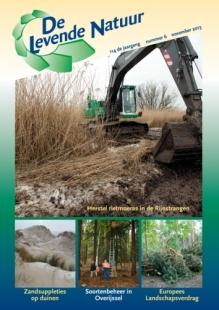De Levende Natuur nummer 6 van 2013 (English summary)
Afbeelding

Hay making with various frequencies: 40 years of impoverishing the soil
J.P. Bakker, Y. de Vries & C. Smit
Hay making without fertilizer application is supposed to impoverish formerly fertilized soils, and restore a plant community characteristic of nutrient-poor soil conditions. A comparison was made between hay making twice a year in July and September, once a year in September, once every second year in September, and abandoning. After nearly 40 years of monitoring, it turned out that the strongest decrease of biomass and the strongest increase in total number of plant species was recorded when hay making was twice a year. We conclude that the most intensive, and hence expensive treatment is needed to impoverish the soil. Further progress to a plant community characteristic of nutrient-poor soil conditions can, however, even not be achieved by hay making twice a year.
Effects of nourishments on dunes
S.M. Arens, F.H. Everts, A.M. Kooijman, E.J. Lammerts, S.T. Leek, M.E. Nijssen, B. van der Valk & N.P.J. de Vries
Coastal defense and nature management are interconnected. Natural processes can contribute to the improvement of coastal defense for example by developing new dunes. Large scale sand suppletion at the beach and nearshore alters the coastal system but effects on geochemistry, ecology and status of special habitat types in Natura 2000 areas in Dutch coastal dunes are not clear. Habitat types include H2110 Embryonic shifting dunes, H2120 White dunes, H2130 Grey dunes and H2190 Humid dune slacks.
Effects of sand suppletion on geomorphology, soil, vegetation and soil fauna of coastal dunes were analyzed. As a direct effect of sand suppletion, sand with higher calcium content is transported over the primary (coastal) dunes. Especially interaction between sand suppletion and dynamics is important. In highly dynamic areas, the zone of White dunes is broader than in low dynamic areas as Grey dunes in the primary (coastal) dune system seem to be replaced by White dunes. No effects on the quality of the vegetation of the Embryonic and White dunes were observed. The Grey dunes do display changes in the quality of vegetation and soil fauna but most are not significant. However, in the Wadden area a positive relation was found between the presence of lichen-rich vegetation and the amount of sand drift.
Experiences with restoration of reed marshes in the nature reserve Rijnstrangen
J.P.M. Lenssen, H. Coops, C. Buddingh & T.B.M. Wijers
The nature reserve Rijnstrangen near Zevenaar is in the dutch river area an important stronghold for reed marshland bird species like Great reed warbler (Acrocephalus arundinaceus) and Great bittern (Botaurus stellaris). Unfortunately, populations of these species have strongly declined since the early 1990s. The decline is to a large extent due to decrease in area and quality of marshland dominated by Common reed (Phragmites australis).
In order to restore the habitat for marshland birds the minimum water level has been raised in 1998 from 8.75 to 9.75 m above Dutch Ordnance level. The rise in minimum water level in 1998 was accompanied by a 40% increase in area of reed. The increase mainly occurred at the land side of the marshes, where tall forbs were replaced by reed.
In 2005 the mean water level during the breeding season (half March- half July) was raised 25 centimeters; the aim was to protect nests of reedmarsh birds against predators such as Fox. This rise in water level brought about a small increase in reedmarsh area. Numbers of breeding marshland birds hardly responded to water level rises, although the proceeding decline of Great reed warbler stopped after 2005.
The limited response of marshland birds, combined with the pollen structure of the reed at the waterside indicate that desiccation is not the only pressure on reedmarshes and that accumulation of organic matter may also underlie deterioration of reed marshes.
Therefore a project was started to remove the organic top layer in the reed beds. As this management measure has rarely been applied on such a large scale in natural reed beds it was mainly ‘learning by doing’. An important lesson was that position of the water table strongly determines the prospects of reed regrowth. Even a few centimeters of flooding inhibited recovery of reed from rhizomes in the subsequent growing season. Most likely, the rhizomes get damaged when scraping off the top organic soil layer. Subsequent flooding of these damaged rhizomes may hamper recovery.
Our experiences in the Rijnstrangen indicate that only raising the minimum water level is not sufficient to improve habitat for reed marshland birds. Conditions that prevent reed litter accumulation are also prerequisite. If water level dynamics is insufficient it is possible to artificially remove organic top soil, provided that the water level can be temporarily lowered.
Six years species management by Landschap Overijssel
M. Zekhuis
This article describes the success of nature management for threatened species in the province Overijssel, between 2005 and 2010. During six years Landschap Overijssel established 241 small scale actions for species in nature reserves and rural area. The actions were taken by professionals and voluntaries. According this evaluation, 75% of the measurements was successful. Important failures were caused by changing environment, wrong or no management after the actions and lack of ecological knowledge of some species. Beside the behold of some species, was the attention for threatened species of people in general and land owners in special also positive.

